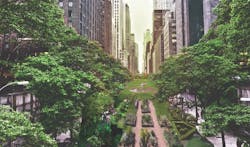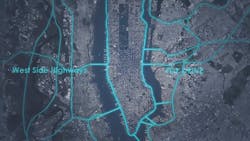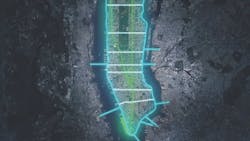Loop NYC would reclaim 24 miles of park space from Manhattan’s street grid
What was once a busy thoroughfare filled with exhaust fumes and the sounds of honking horns becomes a quiet strip of land, its oil-stained concrete reclaimed by nature and the angry honks of traffic relegated to the past. This reclamation of New York’s streets may seem like a post-apocalyptic vision in a dystopian summer blockbuster, but it’s actually a radical new proposal from New York-based Edg, an architecture, engineering, and consulting firm, that would bring 24 miles of park space to New York City’s street grid.
Loop NYC leans heavily on driverless cars to create a new traffic flow around Manhattan. Existing cross streets and highways are converted into driverless expressways to optimize traffic flow in and out of the city.
The FDR and West Side highways will have one lane of traffic in each direction designated for autonomous vehicles. These highways will connect to major Manhattan streets, which themselves will be transformed into driverless car expressways. Featuring driverless vehicles exclusively would be 14th Street, 23rd Street, 34th Street, 42nd Street, 57th Street, 86th Street, and 110th Street. Pedestrian overpasses and underpasses will be installed around these streets to physically separate the vehicles and the pedestrians.
The driverless cars can circulate using any combination of the new expressways and loops to expedite travel. Edg calculated the efficiency of Loop NYC to go from Grand Central Station to Lower Manhattan and back. This route would traditionally take about 40 minutes. With the Loop NYC plan in place it would only take 11 minutes.
With the more efficient traffic flow, once congested streets could be reclaimed as park space with walking paths and bike lanes. A 13-mile-long pedestrian park would stretch from Battery Park in Lower Manhattan, run through Union Square, and then continue north on Broadway and Park Avenue. Broadway will become its own linear park filled with pathways and pedestrian bridges meant to mimic natural rolling hills.
The proposal builds on a current theme found in cities around the world to become greener, more pedestrian-friendly, and less reliant on cars. However, Loop NYC remains highly speculative for several reasons. Chief among them is the fact that a world of truly autonomous cars is still years away.



